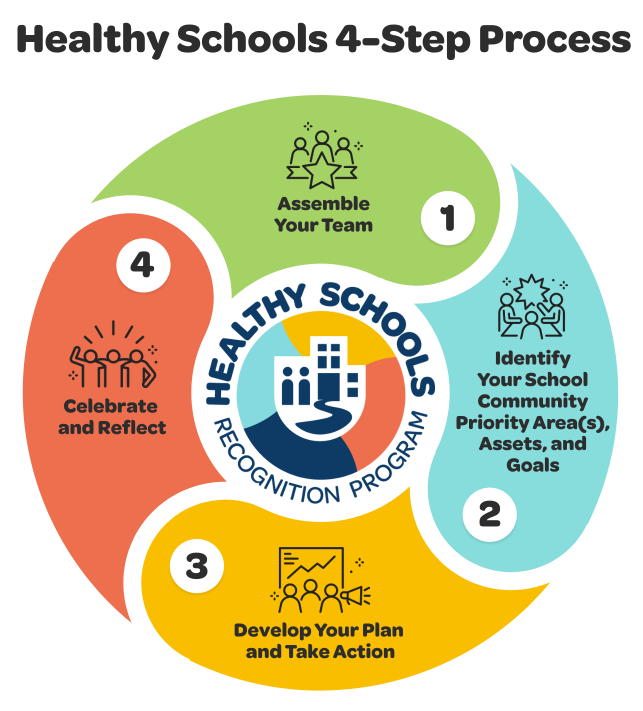The Healthy Schools Recognition Program is based on the Healthy Schools Process, which includes 4 Steps that support school communities in taking a planned and comprehensive approach to address health-related priorities throughout their Healthy Schools journey.
The Healthy Schools Process encourages the engagement of staff, students, parent(s)/caregiver(s), and the community in the identification of your school’s priority areas, setting goals for your Healthy Schools journey, making a plan and taking action to address the priority areas and reach the goals set, and celebrating and reflecting on the achievements during this journey. Together, the 4 Steps promote a comprehensive, inclusive, and whole-school approach to Healthy Schools, centring student belonging and well-being, and promoting greater long-term success and sustainability in improving health outcomes among students and others in the school community.
The Healthy Schools Process includes the following 4 Steps:
Step 1: Assemble Your Team
Forming a Healthy Schools Team creates a foundation for sustainable change by building shared ownership, encouraging collaboration, and amplifying student voice. A school team can help inspire your school’s journey by bringing together a range of perspectives that can provide input and voice into the needs, interests, and priorities of the school community. Your Healthy Schools Team should include a combination of students, school staff members, a principal/vice-principal, parent(s)/caregiver(s), and community partners. Leveraging existing school teams or clubs, like a Health and Wellness Club, can be a great starting point!
Step 2: Identify Your School Community Priority Area(s), Assets, and Goals
To ensure that your school journey is focused, meaningful, and meets the needs and strengths of your school community, work with your team to identify priority area(s), school assets, and goals. Collecting information from the school community is an important part of this step. Priority area(s) should be identified in a collaborative way with students, staff, and the broader school community and should reflect the health priorities of the school community. When students are leaders in and contribute to this process, the priorities reflect their interests and lead to increased engagement and connectedness.
Step 3: Develop Your Plan and Take Action
Work with your team to develop a plan that transforms your school’s priority area(s) into meaningful initiatives with school-wide impact. When students help design and carry out the plan, they build leadership skills, take ownership of the process, and see their ideas come to life, making the plan more relevant and effective. Your team should implement and monitor the initiatives and update your plan, as well as any changes/modifications to initiatives, as your journey progresses to document the Healthy Schools activities that took place during your journey. Leveraging existing health and well-being initiatives that already take place at your school can be a great place to start!
Step 4: Celebrate and Reflect
Celebrate the contributions of each team member and reflect on your Healthy Schools journey, including what you’ve learned and what impact you’ve had on your school. Recognizing and celebrating the contributions of those involved, especially students and their leadership, can deepen their learning, strengthen team identity, and help build momentum for continued work ahead.


